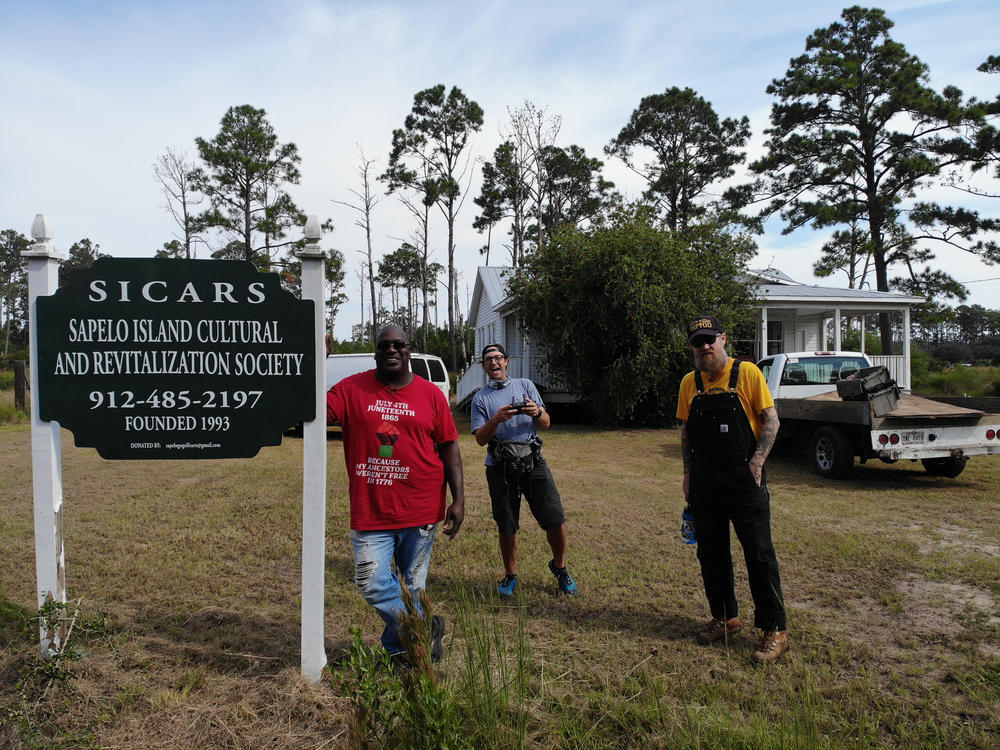
Section Branding
Header Content
A Fork in the Road Podcast: Sapelo Island Cultural Revitalization - Part 1
Primary Content
Sapelo Island is home to the last intact Gullah Geechee community in the Sea Islands of Georgia. It is comprised of direct descendants of slaves that were brought here in 1802. This episode of the Fork in the Road podcast is about the revitalization of an African American community that has existed in Georgia for more than 200 years.

(TRANSCRIPT)
Maurice Bailey: Having an agriculture program, to me, it's putting us back on the map. Bringing products from Sapelo to the mainland, bringing plants back, crops back that we've done for generations, which is part of our heritage. So all this connection to me is helping us keep our community alive. So our story goes on with our crop, and that's part of keeping our heritage going.
David Zelski: There's an island south of Savannah that is home to the last intact Gullah Geechee community in the Sea Islands of Georgia. And it's comprised of direct descendants of slaves that were brought here in 1802. This episode is about the revitalization of an African community that has existed in Georgia for more than 200 years.
Theme Song: I came from the mud, there's dirt on my hands. Strong like a tree, there's roots where I stand.
David Zelski: I'm David Zelski, and this is the Fork in the Road podcast featuring the stories of Georgia's farmers, fishermen, merchants, artisans, chefs and others who helped provide Georgia grown products to folks in the Peach State and beyond. Today we're talking to Maurice Bailey and Dr. Nik Heynen. Maurice is the Director of the Sapelo Island Cultural Revitalization Society, or SICARS, and is also a resident.
Maurice Bailey: I grew up with sugar cane, so we all had our sugar cane patch. We all went down the Allen Green to grind out sugar cane. As kids, you we helped them to get the firewood. They produced the syrup we sitting there eating cornbrad and hot biscuit as the women cooking down the syrup in the men's grind the sugar cane.
David Zelski: Dr. Nik is a professor of geography at UGA and he's co-director of the Cornelia Walker Bailey Program on Land and Agriculture.
Dr. Nik Heynen: So I was recruited to come here initially by Dr. Merryl Alber, who is the director of UGA's Marine Institute, recognized that there had been too little interaction between the community and the university.
David Zelski: I want to paint a picture of where we are. Sapelo Island is a barrier island just off the Georgia coast. As a part of McIntosh County, it lies about 60 miles south of Savannah and 40 miles north of Brunswick. The island is 12 miles long and 3.1 miles wide. 97% of Sapelo Island is owned by the state of Georgia and managed by the Georgia Department of Natural Resources. In fact, it is illegal to visit the island without a permit issued by state tourism authorities. The residents that live here are in the small community of Hog Hammock. Sapelo has a rich history of agriculture, and today we will learn how Maurice, Dr. Nik, and the Sapelo Island Cultural Revitalization Society are helping to reestablish crops on Sapelo Island that they hope will enable the future for the Gullah Geechee people.
Maurice Bailey: So I grew up with sugar cane, I grew up with red peas, I grew up with sweet potato. I grew up all the natural herbs because we didn't have medicine and we didn't have doctors available. It was a way to survive and we had to do it to survive. Because there was no going to the grocery stores.
David Zelski: He's right. There's no running to the grocery store on Sapelo Island. While there is a small general store now, the closest WalMart or Publix or anything else is a 30 minute ferry ride that is only offered three times a day and just twice on Sundays.
Maurice Bailey: So to me, the crops are very important and it is something that I want to pass along. I don't want to forget about that. I don't want to let this part of our heritage go. Because once its gone, It's not going to come back.
David Zelski: And passing along this heritage is exactly why SICARS is here. Let's now hear from Dr. Nik to find out how he got involved.
Dr. Nik Heynen: I never knew anything about the place and came and eventually reached out to someone named Jasper Watts, who said he wouldn't talk to me until I had the blessings from Miss Cornelia. And so I went and knocked on her door and she told me she didn't have time to talk to me. So the next trip I did that again. I did that...took me a couple of months to get in to talk to her. Finally, when I got in and started sitting in her kitchen and then asking the question, how could UGA be a better partner? What could we do? She brought me into the history of SICARS and previous efforts to get agriculture going and asked if I would help do that. And I said yes.
David Zelski: And it wasn't only Nik and UGA bringing this agriculture program to life. A lot of help was offered.
Dr. Nik Heynen: The state DNR said, Hey, sign here. Doug Sampson They both offered support at various stages and Maurice's brother, Stanley Walker, he has a knowledge of the island that we oftentimes kind of draw upon and ask him questions about things.
David Zelski: So you guys are nerding out together?
Maurice Bailey: He said "nerding out" Yes, Yes, that's Nik. The nerding out....but we learn from each other. So we have a you each other's strength to keep this project going. He has knowledge I don't have and I have knowledge he don't have. We just put two together and it's it's a good combination. Yeah. Yeah. But he do be nerding out.
David Zelski: It sounds like they're having a good time nerding out while also preserving agricultural history. So we know the crops are important. But exactly which crops and why?
Maurice Bailey: Well, what we have now is the red peas is still a great seller. We hope to increase that next year. The sugar cane. It's going to be one of our biggest crops, probably bigger than red peas. And we try to plant crops that it doesn't take a lot of maintenance for that, pretty much take care of it themselves. But once again, we're faced with that labor pool to maintain a lot of crops. So the red peas, the sugar cane, the garlic that we getting into, the indigo that we started getting to, these are the crops that we, we think also have a market for it. Bring you bring you yield more for these crops any than other crops. We chose these crops also because we can, easy to manage and yield more from these crops once we harvest.
David Zelski: Agriculture takes a lot of care and science. So let's take a look at Maurice's process of harvesting red peas. So, Maurice, when are they planted?
Maurice Bailey: It depends on the weather. We can start end of February, March we can plant them. And it only take like three days for them to come up. So if we plant in a timely manner, we get like three crops in the red peas every year. We usually pick it by hand a lot of time, we pick all the dead ones out, the light colored ones we pick out. Because if you leave these and replant, it's going to start turning all of them this color. And we want the true red peas. So these have to go. Over the last three years, we have managed to almost eliminate all the clay color peas from the red peas. After I wash them and dry them a little bit, I actually put them in the oven for a few minutes. In the oven would kill the the growth cell. So then you take it out and take it out of it. Let it cool and you package it. It doesn't hurt at all. Except for it will not reproduce. So it's kind of we are keeping our crop, you know, traditional crop.
David Zelski: What can you do with red peas?
Maurice Bailey: Well, mostly in this area we like to make Hoppin John. So for New Years, everybody want red peas for Hoppin John. So we probably got another three containers like this. And so as Thanksgiving and New Year's come around and people say, Y'all got any red peas, we want some red peas because everybody wants to make Hoppin John. You can cook it by itself, just some peas by itself, or we cook it with rice mostly. So that's our traditional thing.
David Zelski: So what is Hoppin John's? Hoppin John's originated from the Gullah people and was a low country one pot dish before spreading to the entire population of the South. Hoppin John's also known as Carolina Peas and rice is a peas and rice dish served traditionally eaten on New Year's Day thought to bring a prosperous year filled with luck. Hoppin John's may have evolved from rice and bean mixtures that were the sustenance of enslaved West Africans enroute to the Americas. All right. Now back to Maurice.
Maurice Bailey: So far, people starting to recognize that we're doing something great initially, just so a bunch of people out here pulling weeds and cutting trees so they didn't see which direction is going. We knew what direction was going. We knew how it could grow and become a strength for the community. So so now that we're finally getting a feel that visible, now that people are aware of what we're doing. I think we are on a great path to be successful in all our efforts over the last three years, four years that we was working on this. And so I think it'll be a great strength for SICARS in the community to have the agriculture program up and running at full capacity over the next two years. That's our goal over the next two years that this program be to full capacity that we actually to the point that we employ people and that's part of having an agriculture program employing people from Sapelo. Whether they will remain on Sapelo on the land or they want to come back to Sapelo. So this project will provide jobs in the near future. And that's just one of the goals that we're trying to do.
David Zelski: Reviving history, sustaining a community and providing jobs. It seems like they have great plans to steadily grow their market. One of those markets is the products made from a popular crop, sugar cane. And to make the tasty products from sugar cane, you need to grind it, which Maurice couldn't initially do on the island.
Maurice Bailey: Thiis is a picture from last year's cane grinding that we had to take our cane grinding off of the island to get it ground. These some of the volunteers from Davidson College to help us grind. It's like a two day process of grinding what sugar cane that we had. So we still hoping that we'll be able to produce this on Sapelo this year. We had a grinder that we're going to establish the next couple of weeks and make this process a little easier. But it's a very nice picture of last year and grinding. So by hand. So we still do the old fashioned where we stick in the cane through there and it presses it, juice comes out. You screen it into a 55 gallon full grade drum. Then carry it on in and cook it down. Last year, the crop that we just gave to the community members, our residents, because we want them to taste our first year of syrup on Sapelo in many years. So everybody loved the syrup. It was very sweet. We got a lot of positive things back from the syrup, so we know that we've got a good product. So this year now we're going to market it off island to individual farmers market that's asking for restaurants asking for it. So we already have a market for this product. We just got to get it off the island.
David Zelski: Think about this. Sapelo Island is only accessible by a 30 minute ferry ride that is only offered three times a day and twice on Sundays. That means when they are moving products, it takes a lot of planning, loading, and ferry trips. Needless to say, there's a lot of work involved. However, there is a little magic on their side. During my time with Dr. Nik and Maurice, we came across an herb that is used for tea and seems to cure whatever ails you
Maurice Bailey: Life Everlasting Tea is a herbal tea that we still drink on the island. So would be good for any kind of illness you have. Arthritis, colds, fever, headache.
David Zelski: It was pretty neat to come across the Life Everlasting.
Maurice Bailey: Yeah.
David Zelski: Tell me about that, why was that special?
Maurice Bailey: Life Everlasting was a miracle plant that was used for a long time. If you had any kind of illness, life everlasting cured it, you know, it's a little life everlasting with little moonshine. That's how you drink it sometimes with a little honey, and you drink that tea, you sweat all night, and the next day you will feel better. So the life everlasting tea is is a tea that everybody still wants. Everybody still have them in the house on Sapelo. They not going to probably tell you about it, but everybody got a little twig in the corner somewhere. So when they sick, they got a little life everlasting.
David Zelski: Who wouldn't buy life?
Maurice Bailey: A lot of people love it. Yeah.
Dr. Nik Heynen: If you if you Google it, it's like crazy.
Maurice Bailey: Yeah. Yeah. There's a market.
Dr. Nik Heynen: On it for their whole kind of health care system.
David Zelski: Every process is carefully crafted to not only help preserve the agriculture, but to also preserve and carry on the heritage of the people who live on Sapelo Island.
Dr. Nik Heynen: I mean, I say, you know, one of the early things that I was paying attention to was the land loss from descendants in the community. There have been a lot of off island wealthy folks starting to develop parcels. And I think back to what Maurice was saying about the crops being the face of the community, I think having having that land in agriculture and hoping to preserve it so it doesn't get developed and so Sapelo doesn't end up like Jekyll, you know, or a whole lot of other places that just are different. It feels like an important goal for me personally.
Maurice Bailey: Having an agricultural program, to me, it's put putting us back on the map, bringing a product from Sapelo to the mainland, bringing plants back, crops back that we've done for generations, which is part of our heritage is. So all this connection to me is helping us keep our community alive. So our product that's be our face of the Geechee people now. We don't have the numbers, but we can have a product and say, this is from Sapelo.
David Zelski: Red peas, sugar cane, Hoppin John, syrup and Life Everlasting. That sounds like a lot, but that is not all that's happening on Sapelo Island. Maurice and Dr. Nik are also working with another potential cash crop.
Maurice Bailey: From a green plant to a blue dye. All natural.
David Zelski: We'll learn more about their work with Indigo next week in part two of this episode on Sapelo Island. If you enjoyed this episode of the podcast, there's plenty more content just like it. You can watch A Fork in the Road on GPB TV or any time on the GPB.org website. GPB.org/Podcasts is where you can listen to and subscribe to this podcast or download it on your favorite podcast platform. I'm David Zelski. Thanks for listening to A Fork in the Road.
The A Fork in the Road TV show airs Saturdays at noon and Sundays at 6:30 a.m. on GPB-TV. Check your local listings for other replays throughout the week and watch all episodes anytime at GPB.org/ForkintheRoad. Please download and subscribe to the Fork in the Road podcast at GPB.org/ForkintheRoadpodcast or on your favorite podcast platform as well.

Sapelo Island is home to the last intact Gullah Geechee community in the Sea Islands of Georgia. It is comprised of direct descendants of enslaved people who were brought here in 1802. This episode of the Fork in the Road podcast is about the revitalization of an African-American community that has existed in Georgia for more than 200 years.





